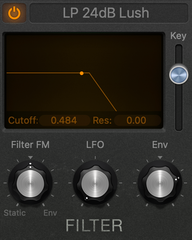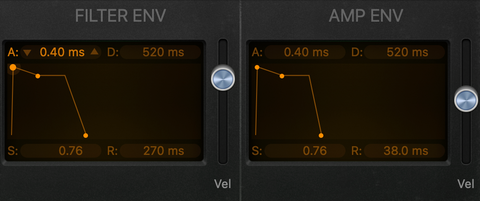Synthesizers have become an essential tool in modern music production, offering a wide range of sonic possibilities that were previously impossible to achieve.
They are complex devices however and have a range of unique terms that do take some time to understand especially if you're new to music production. What is an LFO? And what does it have to do with making sounds?
Well.. to understand how synthesizers work, it is essential to understand the various components that make up a synthesizer.
In this article, we will define and discuss the most fundamental synthesizer components, including oscillators, filters, envelopes, LFOs, and effects.
Oscillators

At the core of every synthesizer is an oscillator. An oscillator generates an audio signal of a particular frequency and waveform. This waveform can be shaped and manipulated to create different sounds. The most common waveform types are sine, triangle, sawtooth, and square.
A sine wave is the most basic waveform and has a smooth, pure tone. It is commonly used for creating bass sounds, as well as for creating sound effects like bells and chimes. A triangle wave has a slightly more complex tone than a sine wave and is commonly used for creating lead sounds. A sawtooth wave has a sharp, cutting tone and is often used for creating pad sounds. A square wave has a harsh, edgy tone and is commonly used for creating bass sounds and percussion sounds.
In addition to waveform type, oscillators also have controls for pitch, octave, and detune. Pitch determines the frequency of the oscillator, while octave determines the octave in which the oscillator plays. Detune controls the degree of tuning between multiple oscillators and is commonly used for creating thick, rich sounds.
Filters

Filters are another essential component of a synthesizer. They are used to shape the frequency content of a sound by selectively allowing certain frequencies to pass through while attenuating others. This allows for the creation of a wide range of tonal variations, from bright and harsh to warm and mellow.
The most common types of filters are low-pass, high-pass, band-pass, and notch filters. A low-pass filter allows frequencies below a certain cutoff point to pass through while attenuating higher frequencies. This results in a warmer, more mellow sound. A high-pass filter does the opposite, allowing higher frequencies to pass through while attenuating lower frequencies. This results in a brighter, more cutting sound.
A band-pass filter allows a range of frequencies to pass through while attenuating frequencies outside of that range. This results in a narrow band of frequencies that can be used to create resonant effects and other tonal variations. A notch filter, also known as a band-stop filter, attenuates a specific range of frequencies while allowing all other frequencies to pass through. This is commonly used to remove unwanted frequencies from a sound.
Envelopes

Envelopes are used to shape the amplitude or volume of a sound over time. They are comprised of four main stages: attack, decay, sustain, and release. The attack stage determines how quickly the sound reaches its peak volume. The decay stage determines how quickly the sound drops from its peak volume to its sustain level. The sustain level determines the volume at which the sound will remain as long as the note is held. The release stage determines how quickly the sound fades out when the note is released.
The envelope is often used in conjunction with a filter to create complex, evolving sounds. For example, a sound with a slow attack and a long release can be combined with a low-pass filter to create a warm pad sound that gradually fades in and out.
LFOs

LFOs, or Low-Frequency Oscillators, are similar to regular oscillators but operate at a much lower frequency range. Instead of generating audio signals, they generate control signals that can be used to modulate other parameters of a sound, such as pitch, filter cutoff, or volume.
The most common waveform types for LFOs are sine, triangle, sawtooth, and square.
Just like regular oscillators. However, LFOs have a much slower frequency range, typically in the range of 0.1 Hz to 20 Hz. This slow modulation can be used to create various effects, such as vibrato, tremolo, and wah-wah.
LFOs can be used to modulate many different parameters of a synthesizer. For example, modulating the pitch of an oscillator with an LFO can create a vibrato effect. Modulating the filter cutoff frequency with an LFO can create a wobbly, sweeping sound. Modulating the amplitude of a sound with an LFO can create a tremolo effect.
Effects

Effects are processing units that can be used to add additional character and depth to a sound. They are typically used to create spatial effects, such as reverb, delay, and chorus. They can also be used to add distortion, compression, or EQ to a sound.
Reverb is an effect that simulates the sound of a space, such as a room, hall, or cathedral. It can be used to add depth and ambience to a sound, making it sound like it was recorded in a large, spacious room. Delay is an effect that repeats a sound at a specified interval, creating an echo effect. It can be used to create rhythmic patterns or to add depth and complexity to a sound.
Chorus is an effect that duplicates a sound and modulates the pitch and timing of the duplicated sound. This creates a thick, rich sound that is commonly used for creating pads and other atmospheric sounds. Distortion is an effect that adds harmonics to a sound, creating a gritty, overdriven tone. It is commonly used for creating aggressive, distorted bass sounds and guitar-like leads.
To Sum Up
In conclusion, synthesizers are powerful tools that offer a wide range of sonic possibilities. To understand how synthesizers work, it is essential to understand the various components that make up a synthesizer, including oscillators, filters, envelopes, LFOs, and effects.
Oscillators are the fundamental sound generators that create waveforms of different types and frequencies. Filters shape the frequency content of a sound, allowing for tonal variations from bright and harsh to warm and mellow. Envelopes shape the amplitude or volume of a sound over time, allowing for dynamic expression and complex evolving sounds. LFOs generate control signals that can be used to modulate other parameters of a sound, creating vibrato, tremolo, and other effects. Finally, effects are processing units that can be used to add additional character and depth to a sound, such as reverb, delay, and chorus.
By understanding these components and how they interact with each other, synthesizers can be used to create a vast range of sounds, from classic analog synthesizer sounds to futuristic, experimental soundscapes. Whether you are a beginner to music production or an experienced producer, mastering these fundamental components will help you unlock the full potential of your synthesizer and take your music production to the next level.

